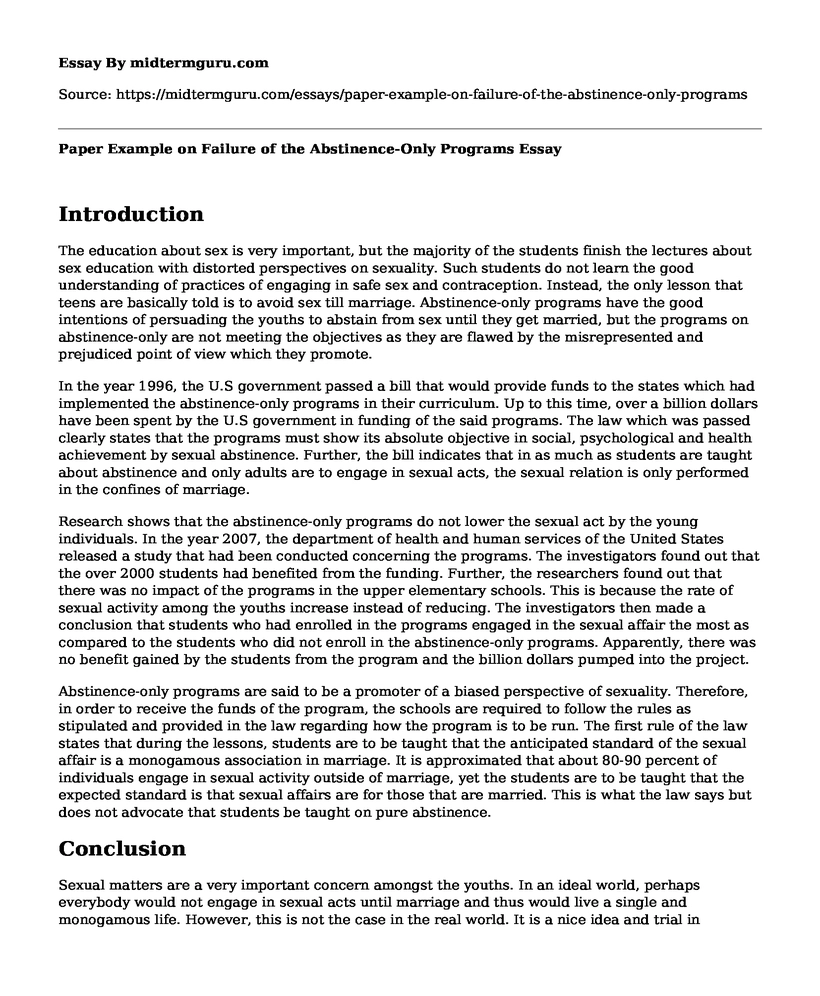Introduction
The education about sex is very important, but the majority of the students finish the lectures about sex education with distorted perspectives on sexuality. Such students do not learn the good understanding of practices of engaging in safe sex and contraception. Instead, the only lesson that teens are basically told is to avoid sex till marriage. Abstinence-only programs have the good intentions of persuading the youths to abstain from sex until they get married, but the programs on abstinence-only are not meeting the objectives as they are flawed by the misrepresented and prejudiced point of view which they promote.
In the year 1996, the U.S government passed a bill that would provide funds to the states which had implemented the abstinence-only programs in their curriculum. Up to this time, over a billion dollars have been spent by the U.S government in funding of the said programs. The law which was passed clearly states that the programs must show its absolute objective in social, psychological and health achievement by sexual abstinence. Further, the bill indicates that in as much as students are taught about abstinence and only adults are to engage in sexual acts, the sexual relation is only performed in the confines of marriage.
Research shows that the abstinence-only programs do not lower the sexual act by the young individuals. In the year 2007, the department of health and human services of the United States released a study that had been conducted concerning the programs. The investigators found out that the over 2000 students had benefited from the funding. Further, the researchers found out that there was no impact of the programs in the upper elementary schools. This is because the rate of sexual activity among the youths increase instead of reducing. The investigators then made a conclusion that students who had enrolled in the programs engaged in the sexual affair the most as compared to the students who did not enroll in the abstinence-only programs. Apparently, there was no benefit gained by the students from the program and the billion dollars pumped into the project.
Abstinence-only programs are said to be a promoter of a biased perspective of sexuality. Therefore, in order to receive the funds of the program, the schools are required to follow the rules as stipulated and provided in the law regarding how the program is to be run. The first rule of the law states that during the lessons, students are to be taught that the anticipated standard of the sexual affair is a monogamous association in marriage. It is approximated that about 80-90 percent of individuals engage in sexual activity outside of marriage, yet the students are to be taught that the expected standard is that sexual affairs are for those that are married. This is what the law says but does not advocate that students be taught on pure abstinence.
Conclusion
Sexual matters are a very important concern amongst the youths. In an ideal world, perhaps everybody would not engage in sexual acts until marriage and thus would live a single and monogamous life. However, this is not the case in the real world. It is a nice idea and trial in convincing the youths to wait until marriage so as to engage in sexual affairs, but the approach of sex education alone cannot work. After a decade of serious funding to the program there has not been a fruitful outcome, however, the situation has even worsened. This is because of the biased view that the program delivers and the information which the programs do not deliver. It is an opportune moment to bring to an end of the abstinence-only program and provide the student with comprehensive sex-educational programs which prepare them well for the future.
Works Cited
Baams, Laura, Judith Semon Dubas, and Marcel AG van Aken. "Comprehensive sexuality education as a longitudinal predictor of LGBTQ name-calling and perceived willingness to intervene in school." Journal of youth and adolescence 46.5 (2017): 931-942.
Kantor, Leslie, and Nicole Levitz. "Parents' views on sex education in schools: How much do Democrats and Republicans agree?." PloS one 12.7 (2017): e0180250.
Pugsley, Lesley. "Focus groups, young people and sex education." Gender and Qualitative Research (1996). Routledge, 2018. 126-142.Rose, India D., and Daniela B. Friedman. "Schools: A Missed Opportunity to Inform African American Sexual and Gender Minority Youth about Sexual Health Education and Services." The Journal of School Nursing 33.2 (2017): 109-115.
Szirom, Tricia. Teaching Gender?: Sex Education and Sexual Stereotypes. Routledge, 2017.
Cite this page
Paper Example on Failure of the Abstinence-Only Programs. (2022, Sep 28). Retrieved from https://midtermguru.com/essays/paper-example-on-failure-of-the-abstinence-only-programs
If you are the original author of this essay and no longer wish to have it published on the midtermguru.com website, please click below to request its removal:
- Sex Trafficking in Barbados: Annotated Bibliography
- LGBT Individuals Versus Heterosexual Counterparts - Paper Example
- A Framework for Child Sexual Health Improvement in England: Changing Community Understanding Of Sexual Violence
- Paper Example on Media's Positive Effect on the LGBTQ Community
- Legalization of Gay Marriages: Breaking Social Barriers in US & UK - Essay Sample
- Understanding Sexual Consent: An Essential Part of Relationships - Research Paper
- Uncovering the Dark Side of Human Sex Trafficking - Essay Sample







